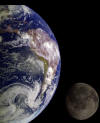
![]()
 |
|
||||
|
|
|||||
|
|
|
|
|
||
![]()
There's only one thing that I couldn't do in my book: show a movie of the giant impact between Earth and Theia. But that is what the Web is good for! Here is a computer-rendered simulation of the scariest day in Earth's history, graciously provided by Robin Canup of the Southwest Research Institute. The simulation is based on a state-of-the-art computer model of the way that rock and iron behave at high temperatures and pressures.
You will need Windows Media Player or a similar program to see the video. When you click on "Watch Video!" it should open up in another window.
About the Animation
The simulation shows the first twenty-four hours after the giant impact. It begins with Theia about to strike the Earth. After the impact, one hemisphere of the Earth is sheared off and flung into space. The remaining part of Earth is very lopsided, and sets up a "gravitational torque" on the debris. This boosts some of the debris into orbit. (Without such a boost, it would all simply fall back down again.)
Within a few hours, the debris has formed an "arm" that smashes spectacularly back into the Earth. This crash is nearly as explosive as the original impact! (The second explosion can be seen much more vividly in the video than in the still frames published in my book.) Notice how the temperature of the Earth has risen, from the blues and greens of the early frames to yellows and reds, indicating more than 2000 degrees Kelvin. Earth has literally become a blast furnace.
As the fateful day continues, the debris gets more uniformly distributed in a disk around the Earth. Notice, though, that this disk is not stable like the rings of Saturn. It develops shock waves that whirl around the Earth, collecting material into spiral arms. According to Alastair Cameron, another modeler of the giant impact, these spiral arms also play an important role in the development of the Moon, by "siphoning" debris up from lower orbits into higher ones. Scientists have estimated that a mass at least twice the present mass of the Moon had to be lifted beyond the "Roche limit," roughly twelve thousand miles or three Earth radii above the surface. Any debris that does not make it past the Roche limit will be torn apart by tidal forces, and cannot form a permanent moon.
This simulation stops after 24 hours, a long time before the disk of debris condenses into our Moon. The Moon was not formed in a day! However, it did form much more rapidly than you might expect; current estimates range from 1 to 100 years. This is astounding, compared to ordinary geological time scales. An entire new planet was born within the life span of a single human.
Robin Canup, who produced this simulation, is one of the leaders at using computers to model the dynamics of the early solar system. It is important to realize that one simulation by itself is only suggestive, not definitive. It takes multiple computer runs, with slightly different initial conditions, to arrive at a good guess at what probably happened and what couldn't have happened. If the conditions to produce a moon like ours were too unique, that actually would work as an argument against the giant impact theory. In fact, Canup and Cameron disagree on some of the details; Cameron has argued that the giant impact took place earlier, with a smaller Earth (which had not finished growing yet) and a larger impactor.
Simulations like Canup's and Cameron's have been instrumental in persuading planetary scientists that (1) giant collisions like the one between Theia and Earth were inevitable in the early solar system, and (2) an impact of this sort is capable of putting enough material, and the right kind of material, into orbit to create a satellite like our present-day Moon.
Go to:
|
|
|
|
Last modified: November 27, 2003